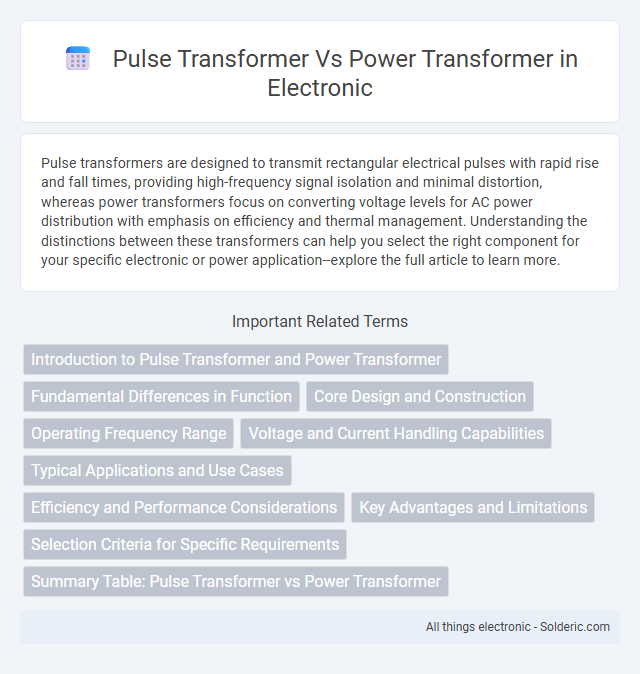Pulse transformers are designed to transmit rectangular electrical pulses with rapid rise and fall times, providing high-frequency signal isolation and minimal distortion, whereas power transformers focus on converting voltage levels for AC power distribution with emphasis on efficiency and thermal management. Understanding the distinctions between these transformers can help you select the right component for your specific electronic or power application--explore the full article to learn more.
Comparison Table
| Feature | Pulse Transformer | Power Transformer |
|---|---|---|
| Primary Use | Signal transmission and pulse shaping | Voltage step-up/step-down in power grids |
| Frequency Range | High frequency (kHz to MHz) | Low frequency (50 Hz to 60 Hz) |
| Core Type | Ferrite core optimized for high frequency | Silicon steel laminated core for efficiency |
| Voltage Rating | Low to moderate voltage | High voltage for power distribution |
| Size | Small and compact | Large and bulky |
| Power Handling | Low power | High power (kVA to MVA) |
| Applications | Digital circuits, radar, communication | Electric power transmission and distribution |
| Impedance Matching | Designed for impedance matching | Generally not designed for impedance matching |
Introduction to Pulse Transformer and Power Transformer
Pulse transformers are specialized transformers designed to transmit rectangular electrical pulses with minimal distortion, commonly used in digital circuits, signal processing, and communication systems to maintain pulse integrity. Power transformers are electrical devices built to transfer energy between circuits at different voltage levels, primarily in power distribution and transmission, ensuring efficient and safe voltage conversion. Both transformers operate on electromagnetic induction principles but serve distinct functions tailored to their application environments.
Fundamental Differences in Function
Pulse transformers are designed to transfer short-duration electrical pulses with minimal distortion and high-frequency response, making them essential in digital circuits and signal processing. Power transformers primarily convert voltage levels in electrical power distribution, operating efficiently at lower frequencies with continuous waveforms to handle large amounts of energy. Understanding these fundamental differences helps you select the right transformer based on whether your application requires precise pulse transmission or robust power conversion.
Core Design and Construction
Pulse transformers feature a core design optimized for high-frequency signals, typically utilizing ferrite cores with low losses and minimal magnetic saturation to handle rapid pulse edges efficiently. Power transformers use laminated silicon steel cores designed for low-frequency operation, prioritizing high magnetic flux capacity and efficient energy transfer in AC power distribution. Construction differences include thinner windings and tighter insulation in pulse transformers to minimize parasitic capacitance and leakage inductance, whereas power transformers employ thicker windings for higher current ratings and thermal management.
Operating Frequency Range
Pulse transformers typically operate in high-frequency ranges from tens of kilohertz up to several megahertz, making them ideal for digital circuits and signal transmission. Power transformers generally function at low frequencies, around 50 to 60 Hz, designed for efficient energy transfer in electrical power distribution. Understanding your application's frequency requirements is essential to selecting the appropriate transformer type for optimal performance.
Voltage and Current Handling Capabilities
Pulse transformers are designed for high-frequency signal transmission with fast rise times and handle lower power levels, typically operating at lower voltages and currents suitable for precise timing and signal isolation. Power transformers manage higher voltage and current levels, optimized for efficient energy transfer in power distribution systems, often dealing with steady-state or slowly varying loads. Your choice depends on whether your application demands high voltage and current capacity for power delivery or high-frequency, low-power signal integrity.
Typical Applications and Use Cases
Pulse transformers are primarily used in high-frequency signal transmission, isolation in switching power supplies, and digital circuits requiring precise timing and pulse integrity. Power transformers serve in electrical power distribution, voltage step-up or step-down in industrial and residential power systems, and energy transfer in large-scale electrical grids. Your choice depends on whether you need accurate pulse shaping and isolation or efficient energy conversion for power delivery.
Efficiency and Performance Considerations
Pulse transformers offer high efficiency and fast transient response, making them ideal for signal transmission and switching applications where minimal energy loss is critical. Power transformers prioritize voltage regulation and load handling, often resulting in lower efficiency under variable loads compared to pulse transformers. Your choice between them should consider the specific performance demands, with pulse transformers excelling in high-frequency, precise energy transfer scenarios.
Key Advantages and Limitations
Pulse transformers offer high-frequency signal transmission with minimal distortion and excellent electrical isolation, making them ideal for digital circuits and pulse applications. Power transformers excel in energy transfer at lower frequencies with high efficiency and reliable voltage regulation, but they are larger and less effective at handling fast transient signals. Your choice depends on whether you prioritize signal fidelity and speed (pulse transformer) or power efficiency and voltage stability (power transformer).
Selection Criteria for Specific Requirements
Selection criteria for pulse transformers versus power transformers depend primarily on frequency, voltage, and application requirements. Pulse transformers are optimized for high-frequency signal transmission and isolation, with low leakage inductance and precise pulse fidelity, making them ideal for digital circuits and communication equipment. Power transformers, designed for lower frequencies and higher power handling, prioritize efficiency, thermal management, and insulation to suit electrical power distribution and conversion needs in your system.
Summary Table: Pulse Transformer vs Power Transformer
Pulse transformers are specialized for transmitting sharp, high-frequency pulses with minimal distortion, featuring low leakage inductance and high coupling efficiency. Power transformers are designed to transfer electrical energy at mains frequencies with emphasis on high power handling, voltage transformation, and thermal management. Your selection between pulse and power transformers depends on application requirements such as frequency range, power capacity, and signal integrity.
pulse transformer vs power transformer Infographic

 solderic.com
solderic.com